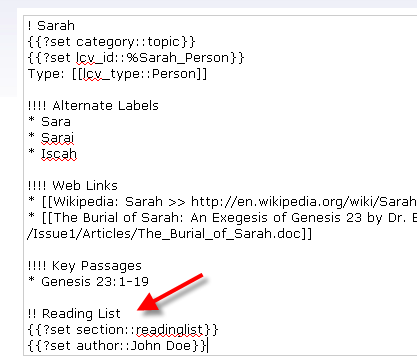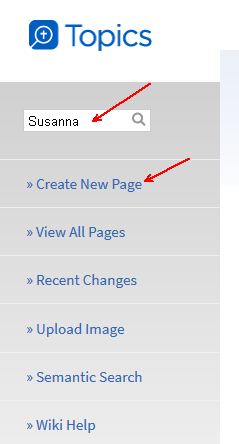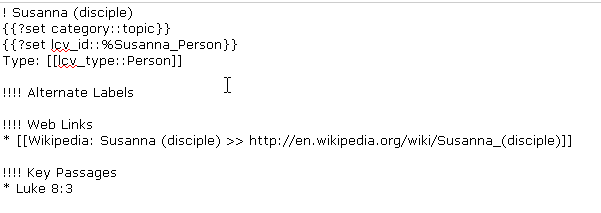Steps in creating a reading list
- Find the wiki page for the topic
- Add the reading list fixed lines
- Add reading list elements as described in the edit process above
Find page for topic
Enter a topic (person, place, writing, etc.) into the Search box of the topics.logos.com wiki.
If the topic is found, select Edit. If the topic is not found, see below for how to add a topic.
Add the 3 reading list fixed lines
The first two lines added after the end of the Key Passages section are always entered exactly as shown. The third line requires replacing “John Doe” with your name.

Add reading list items
The adding of reading items is done as described in editing a reading list. These is, as yet, no standard way to organize the readings.
Add a topic page
In general, Logos expects to preload the Logos Controlled Vocabulary topics into topics.logos.com. However, you will find topics that are not yet in the wiki.
Steps in adding a new topic:
- Verify that the topic does not exist before creating a blank topic
- Find a similar topic
- Add heading lines
- Add topic lines
- Add wikipedia entry
- Optionally, add reading list lines
- Save your work
Verify that the topic does not exist before creating a blank topic.
For this example, we will take Susanna from the deuterocanonical (apocryphal) portion of Daniel.
The first step is to search on the topic “Susanna”. This returns only one result – the New Testament Susanna.

So click on Create New Page to begin a new page for Susanna from the book of Daniel.
Find a similar topic
The basic heading lines for a topic give its displayed name, the type and subtype and an internal name; in other words it contains the technical ‘stuff’ that makes the wiki work. The best way to fill this section is to find a similar entry, copy the lines into your new page, and modify them to fit your topic.
For a similar topic, take Susanna the disciple. In edit mode, copy the heading information:

Add heading lines
Paste the heading information from the similar topic into the new topic page. Modify the Title and the lcv_id to be unique.

The header information varies by the category of the topic. These are typical examples:








Until we are given a complete list of defined values, it is safest to simply copy and modify from a related page.
Add topic lines
The headings under topics have been discussed above. Simply insert the fixed lines:

Add wikipedia entry
Logos has included wikipedia entries in the preloaded entries. If a wikipedia entry is available, add it to your new page.

Optionally, add reading list lines
This is described in detail above. In other words, it is the same as adding a reading list to an existing topic.
Save your work
Review your changes then click on the wiki Save button.